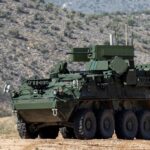
Boeing [BA] on Wednesday detailed the work included in a May contract from the Missile Defense Agency (MDA) to continue longstanding work on the National Team–Systems and Engineering contract. The original announcement said this would have the company continue MDA’s work on “highly specialized follow-on efforts, as required, to achieve Department of Defense mandated capability improvements, through a continuance of these highly complex systems engineering and integration (SE&I)-related efforts.” DoD also said NT-S will continue to provide complex SE&I data…

 By
By 











